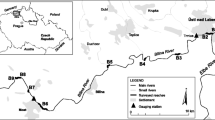Abstract
This study aims to experimentally and numerically investigate the fluvial processes of channels disturbed through sand or gravel mining. A two-dimensional numerical model is applied to simulate flume experiments. A moving boundary-fitted coordinate system is used to describe the channel changes. As a numerical scheme, the cubic interpolated pseudoparticle method is used to calculate the flow field and bed changes, which introduces little numerical diffusion. The numerical model is verified with experimental data. The inflow sediment from the upstream is trapped into a pit and the sediment deposit wedge migrated to the downstream with a steep submerged angle of repose. The numerical and experimental results show that the sediment deposit wedge in the pit migrates to the downstream under the condition of steady state. The adjustment time within the disturbed channels increases as the dimension of the pit is increased. The sediment mining pit migrates with speed in the steep channel. Moreover, the numerical experiments show that the migration speed is proportional to the sediment inflow. And the disturbed channels by the sediment mining are affected by the sediment inflow conditions of the upstream and adjusted to the new state of equilibrium.
Similar content being viewed by others
References
Brandt, S. (2000). “Classification of geomorphological effects downstream of dams.” Catena., Vol. 40, Issue 4, pp. 375–401.
Cao, Z. and Pender, G. (2004). “Numerical modelling of alluvial rivers subject to interactive sediment mining and feeding.” Advances in Water Resources, Vol. 27, No. 5, pp. 533–546.
Chaw, K. W., Wu, C. L., and Li, Y. S. (2005). “Comparison of several flood forecasting models in Yangtze river.” J. Hydrologic Eng., ASCE, Vol. 10, No. 6, pp. 485–491.
Gill, M. A. (1994). “Hydrodynamics of mining pits in erodible bed under steady flow.” J. Hydraul. Eng., ASCE, Vol. 120, No. 11, pp. 1337–1348.
Gob, F., Houbrechts, G., Hiver, M., and Petit, F. (2005). “River dredging, channel dynamics and bedload transport in an incised meandering river (the river Semois, Belgium).” River Res. Applic., Vol. 21, Issue 7, pp. 791–804.
Jang, C.-L. and Shimizu, Y. (2005). “Numerical simulation of relatively wide, shallow channels with erodible banks.” J. Hydraul. Eng., ASCE, Vol. 131, No. 7, pp. 565–575.
Kishi, T. and Kuroki, M. (1976). “Bed form and flow resistance in alluvial rivers (I).” Research Pep., Faculty of Engineering, Hokkaido Uni., Vol. 67, pp. 1–23 (in Japanese).
Kondolf, G. M. (1994). “Geomorphic and environmental effects of instream gravel mining.” Landscape and Urban Planning, Vol. 28, Issue 2, pp. 225–243.
Kondolf, G. M. (1997). “Hungry water: Effects of dams and gravel mining on river channels.” Environmental Management, Vol. 21, No. 4, pp. 533–551.
Kondolf, G. M., Piegay, H., and Landon, N. (2002). “Channel response to increased and bedload supply from land use change: Contrast between two catchments.” Geomorphology, Vol. 45, pp. 35–51.
Kuroki, M. and Kishi, T. (1984). “Regime criteria on bars and braids in alluvial straight channels.” Proc., JSCE, Vol. 342, pp. 87–96 (in Japanese).
Lee, H. Y., Fu, D. T., and Song, M. H. (1993). “Migration of rectangular mining pit composed of uniform sediments.” J. Hydraul. Eng., ASCE, Vol. 119, No. 1, pp. 64–80.
Lee, H. Y. and Hwang, S. T. (1994). “Migration of backward-facing step.” J. Hydraul. Eng., ASCE, Vol. 120, No. 6, pp. 693–705.
Meyer-Peter, E. and Muller, R. (1948). “Formulas for bed-load transport.” Proc. 2nd Congress, IAHR, Vol. 2, No. 2, Stockholm, Sweden, pp. 39–64.
Rinaldi, M., Wyzga, B., and Surian, N. (2005). “Sediment mining in alluvial channels: Physical effects and management perspects.” River Res. Applic., Vol. 21, Issue 7, pp. 805–828.
Van Rijn, L. C. (1996). “Sedimentation of dredged channels and trenches.” Handbook of Coastal and Ocean Engineering, pp. 611–650.
Williams, G. P. and Wolman, M. G. (1984). Downstream effects of dams on alluvial rivers, Geological Survey Professional Paper 1286, U.S. Government Printing Office, Washington, DC.
Wu, W. and Wang, S. S. Y. (2008). “Simulation of morphological evolution near sediment mining pits using a 1-D mixed-regime flow and sediment transport model.” World Environmental and Water Resources Congress, pp. 1–10.
Yabe, T., Ishikawa, T., Kadota, Y., and Ikeda, F. (1990). “A numerical Cubic-Interpolated Pseudoparticle (CIP) method without time splitting technique for hyperbolic equations.” J. Phy. Soc. Japan, Vol. 59, No. 7, pp. 2301–2304.
Author information
Authors and Affiliations
Corresponding author
Rights and permissions
About this article
Cite this article
Jang, CL., Shimizu, Y. & Lee, G.H. Numerical simulation of the fluvial processes in the channels by sediment mining. KSCE J Civ Eng 19, 771–778 (2015). https://doi.org/10.1007/s12205-012-0608-7
Received:
Revised:
Accepted:
Published:
Issue Date:
DOI: https://doi.org/10.1007/s12205-012-0608-7




